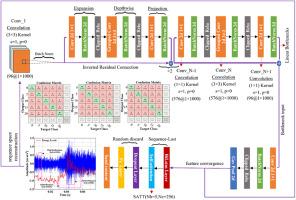Enhancing the reliability of marine pipeline transportation systems: A flow safety monitoring method for sand-carrying churn flows via multi-migration collision behavioral responses
IF 5.5
2区 工程技术
Q1 ENGINEERING, CIVIL
引用次数: 0
Abstract
Marine pipeline transportation systems frequently encounter sand-carrying churn flows, wherein persistent sand particle-wall collisions lead to structural degradation of pipelines. This paper proposes a flow safety monitoring method for sand-carrying churn flows based on multi-migration collision behavior responses. Based on the Robust Empirical Mode Decomposition (REMD) algorithm, this study first establishes a multi-frequency scale vibration response characterization method of sand particles for sand-carrying churn flow. Then, a lightweight deep learning architecture based on Depthwise Separable Convolution (DSC) is constructed, achieving an average recognition accuracy of 87.17 % for sand features with contents ranging from 0g to 20g (in 5g increments) across three distinct datasets. Furthermore, the Bidirectional Long Short-Term Memory (BiLSTM) module and Self-Adaptive Temporal Transformer (SATT) module into the DSC framework, thereby enhancing bidirectional full-sequence time-delay feature extraction capability and adaptive weight-matching capacity for holistic particle characteristic information. The DSC-BiLSTM-SATT recognition model improves the average recognition accuracy by 8 %, achieving a final accuracy of 95.17 %. The model shows excellent generalization capability even on low signal-to-noise ratio (SNR) datasets, and the average recognition accuracy for three low SNR datasets reaches 89.73 %. The framework with high accuracy significantly contributes to improve the flow safety and reliability of marine pipeline transportation systems.

提高海上管道运输系统的可靠性:基于多迁移碰撞行为响应的携沙搅拌流流动安全监测方法
海洋管道运输系统经常遇到携砂搅拌流,其中持续的砂粒与管壁碰撞导致管道结构退化。提出了一种基于多偏移碰撞行为响应的携沙搅拌流安全监测方法。本研究基于鲁棒经验模态分解(Robust Empirical Mode Decomposition, REMD)算法,首次建立了携砂搅拌流砂粒的多频尺度振动响应表征方法。然后,构建了基于深度可分离卷积(DSC)的轻量级深度学习架构,在三个不同的数据集上,对含量从0g到20g(以5g为增量)的沙子特征的平均识别准确率达到87.17%。进一步,将双向长短期记忆(BiLSTM)模块和自适应时间转换器(SATT)模块纳入DSC框架,增强了双向全序列时延特征提取能力和粒子整体特征信息的自适应权重匹配能力。DSC-BiLSTM-SATT识别模型的平均识别准确率提高了8%,最终准确率达到95.17%。该模型即使在低信噪比数据集上也表现出良好的泛化能力,对3个低信噪比数据集的平均识别准确率达到89.73%。该框架精度高,对提高海上管道运输系统的流动安全性和可靠性具有重要意义。
本文章由计算机程序翻译,如有差异,请以英文原文为准。
求助全文
约1分钟内获得全文
求助全文
来源期刊

Ocean Engineering
工程技术-工程:大洋
CiteScore
7.30
自引率
34.00%
发文量
2379
审稿时长
8.1 months
期刊介绍:
Ocean Engineering provides a medium for the publication of original research and development work in the field of ocean engineering. Ocean Engineering seeks papers in the following topics.
 求助内容:
求助内容: 应助结果提醒方式:
应助结果提醒方式:


